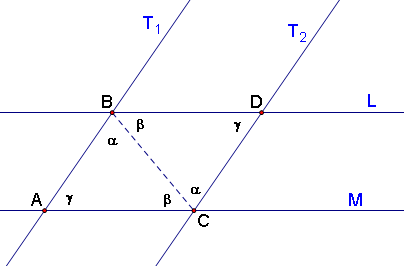
Proof of Triangle Angle Sum
by Kristina Dunbar, University of Georgia
and Michelle Corey, Russell Kennedy, Floyd Rinehart, UGA
Triangle Angle Sum:
The sum of the interior angles of a triangle is 180º. More precisely, if A, B, and C are distinct points, then a(ACB) + a(CBA) + a(BAC) = 180.
Proof:

Let's start with the given points A, B, and C. We can construct a line M through points A and C, then a line at point B that is parallel to AC, called L. We can do this by the existence of parallel lines. Then, by the line axiom, we can create a line T1 going through points A and B, and a line parallel to T1 at C, called T2. This gives us the point D, the intersection of T2 and L. Now we have two sets of parallel lines: T1||T2 and L||M.
We know that γ + (α + β) = 180º because they are the same side interior angles of the transversal T1 that crosses L and M.
Then we can look at parallel lines T1 and T2 and see that α (angle ABC) = α (angle BCD) because of alternate interior angles. See picture above.
However, we also know that when we look at parallel lines T1 and T2 where M is the transversal, that same side interior angles must be supplementary, i.e. = 180º. Then we know that the β's must be the same, because we will get that (α + β) + γ = 180º. Now look at triangle ABC, where the three angle measurements are α, β, and γ, so the sum of the interior angles of a triangle is 180º.
|| Parallels Main Page || Kristina Dunbar's Main Page || Dr. McCrory's Geometry Page ||